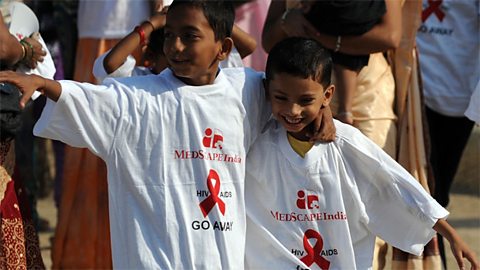Strategies adopted to manage AIDS
There is still no cureThe end of a medical condition when people are made better. for AIDS so most efforts concentrate on prevention. health education programmesSchemes which are set up to make people aware of issues relating to their health and wellbeing. warn of the risks of unprotected sex and of shared needles.

These programmes include advertising on TV and radio as a number of people in the affected areas may be illiterateThe inability to read and write.. The distribution of free condoms was also designed to help people practise safe sex and young people are also encouraged to abstain from sex until after marriage.
AIDS awareness campaignsWork in an organised and active way toward a particular goal, eg raise awareness of the risks of smoking., such as UNAIDS World AIDS Day, are used to highlight the dangers and causes of AIDS. Compulsory testing for AIDS is also used to identify those with the disease.
Large-scale projects such as the Global Aids InitiativeAn organisation set up to save the lives of people suffering from HIV and AIDS around the world. and national initiatives, eg in South Africa, were started with the aim of providing drugs such as ARV – antiretroviral therapy - as well as giving out free condoms to communities along with educational campaigns.
There is increased funding to tackle the disease from sources such as the World BankAn international bank set up to help poorer countries develop. This might be through lending them money for development projects.. Some of this is put into research into developing an AIDS vaccineSubstances containing disabled antigens of a particular disease, usually administered via injection. Vaccines stimulate the body to produce antibodies to provide immunity against that disease..
In developed countries drug therapy programmesTreatment that involves using medication to treat disease. do help to control the disease and prolong the lives of AIDS sufferers. Blood is also screened before use in transfusions and disposable syringesA simple piston pump that contains a plunger that is pushed to administer an injection; thrown away after use. are used in hospitals. Availability of testing is also important so that people know if they have the disease and can take actions to ensure it is not spread.
Effectiveness of strategies
Although there has been a significant increase in funding for AIDS research there is still not enough. There has been no breakthrough in the development of a vaccine to cure the disease.
Therefore the effectiveness of current methods used to control AIDS have varied significantly between developed and developing countries, with much more success in developed countries.
Developed countries:
- Can afford the drugs available.
- Can afford to research and trial new drugs.
- Countries with good quality health services have managed to reduce the spread of the disease, although drug therapy can produce serious side effects.
- Medication has so far not been overly effective.
Developing countries:
- Drugs are available, but not enough staff are trained in administering them, eg in South Africa.
- There are many isolated areas which are difficult to access.
- Many people are not aware they have the disease, which causes it to spread.
- There are many misconceptions about the spread of HIV.
- There is a high birth rate, even among infected women.
- Testing facilities are often poor.
- Some people try to avoid being tested.
- Newer, more effective drugs or those with fewer side effects are too expensive and drug companies are not willing to reduce prices.
- Large numbers of the population are illiterate which makes educational campaigns difficult.
- There may also be many different local dialectDifferent spoken forms of the same language. and languages.
- Countries may have other priorities in terms of spending.